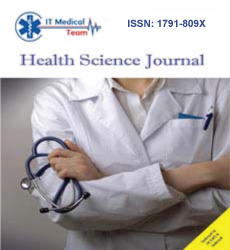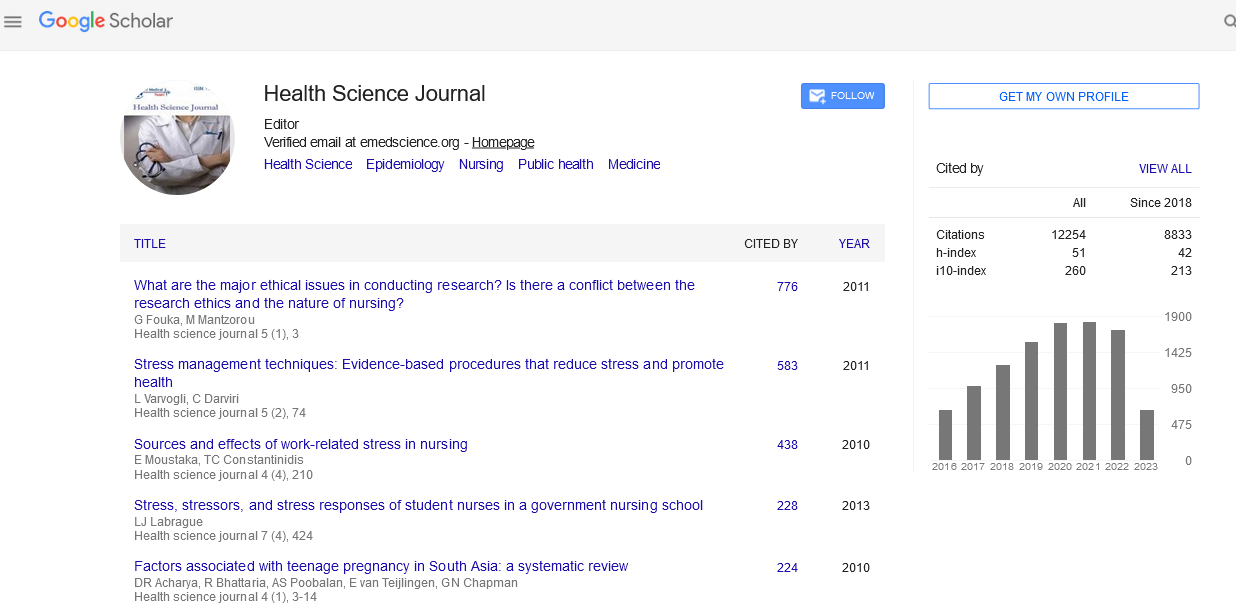Editorial - (2024) Volume 18, Issue 12
Nanotechnology in Alternative Medicine
Ryoji Taniguchi*
Department of Health, University College London, United Kingdom
*Correspondence:
Ryoji Taniguchi, Department of Health, University College London,
United Kingdom,
Email:
Received: 01-Dec-2024, Manuscript No. Iphsj-24-15446;
Editor assigned: 04-Dec-2024, Pre QC No. Iphsj-24-15446 (PQ);
Reviewed: 26-Dec-2024, QC No. Iphsj-24-15446;
Revised: 28-Dec-2024, Manuscript No. Iphsj-24-15446 (R);
Published:
31-Dec-2024, DOI: 10.36648/1791-809X.18.12.1207
Abstract
Nanotechnology, the science of manipulating matter at the atomic or molecular scale, has emerged as a groundbreaking field with applications spanning medicine, electronics, energy, and materials science. In recent years, there has been growing interest in the integration of nanotechnology into alternative medicine. While alternative medicine encompasses a diverse range of practices and therapies, including herbal remedies, acupuncture, and homeopathy, nanotechnology offers novel ways to enhance the efficacy and precision of these treatments. This article explores the potential role of nanotechnology in alternative medicine, focusing on its application in drug delivery, diagnostic tools, therapeutic interventions, and improving the bioavailability of natural compounds. The article also discusses the challenges and ethical concerns associated with the incorporation of nanotechnology into alternative medicine practices and suggests future directions for research and application.
Introduction
Alternative medicine refers to a broad range of health practices that fall outside the conventional medical model, often emphasizing holistic, natural, or preventative approaches [1]. With a growing global interest in holistic healthcare, many people are turning to alternative therapies to complement or replace traditional treatments for various health conditions. While alternative medicine often relies on natural substances and energy-based practices [2], the field has begun to explore cutting-edge technological advancements, such as nanotechnology, to enhance its efficacy and delivery methods. Nanotechnology is defined as the manipulation of matter at the nanoscale—typically within the range of 1 to 100 nanometers. This small scale allows for the creation of nanoparticles and materials that have unique properties, including increased surface area, enhanced reactivity, and the ability to interact with biological systems at a molecular level. Nanotechnology's potential in medicine, particularly in drug delivery systems, diagnostics, and therapy, is well established in conventional healthcare [3]. However, its application in alternative medicine is an emerging area of interest, holding promise for improving the delivery and effectiveness of natural treatments. This article explores how nanotechnology is being incorporated into alternative medicine, examining its applications, benefits, and challenges. We also assess the potential for nanotechnology to bridge the gap between traditional and alternative healing practices, offering a novel way to enhance patient outcomes [4].
Nanotechnology in Drug Delivery
One of the most promising applications of nanotechnology in alternative medicine is in the development of advanced drug delivery systems. Many alternative medicines, such as herbal supplements, plant-based compounds, and essential oils [5], are known for their therapeutic properties, but their effectiveness is often limited by issues such as poor bioavailability, solubility, or stability. Nanotechnology can address these challenges by enhancing the delivery and absorption of these compounds. Nanoparticles can be engineered to encapsulate active ingredients, protecting them from degradation and ensuring that they are delivered to the target site in the body. This is particularly important for compounds with low water solubility or those that are easily metabolized before reaching their intended destination [6]. By using nanoparticles, it is possible to improve the bioavailability of compounds such as curcumin (found in turmeric), resveratrol (found in grapes), and other bioactive molecules, which are commonly used in alternative medicine for their anti-inflammatory, antioxidant, and anticancer properties. Moreover, nanotechnology allows for controlled release mechanisms, enabling the gradual release of therapeutic agents over time. This can improve the efficacy of treatments and reduce side effects by maintaining optimal concentrations of the active ingredients in the bloodstream. This is a key advantage in the context of alternative medicine, where natural compounds are often used in lower doses or in combination with other therapies to support overall health and wellness [7].
Nanotechnology in Diagnostic Tools
In addition to drug delivery, nanotechnology also holds great potential for enhancing diagnostic tools used in alternative medicine. Traditional diagnostic methods in alternative medicine, such as pulse diagnosis in Ayurvedic medicine or tongue analysis in Traditional Chinese Medicine (TCM), rely on practitioners' observations and interpretations of physical signs and symptoms [8]. However, these methods lack the precision and objectivity that modern diagnostic techniques offer. Nanotechnology can improve the accuracy of diagnosis by providing highly sensitive, precise, and non-invasive tools. For example, nanosensors can be used to detect specific biomarkers in the body, enabling the early detection of diseases or imbalances that are often the focus of alternative medicine practices. These sensors could be integrated into wearable devices or other diagnostic instruments [9], allowing for real-time monitoring of health parameters, such as blood sugar levels, hormone fluctuations, or inflammation markers. Additionally, nanoparticles can be used to enhance imaging techniques, improving the visualization of internal organs, tissues, and cells. This could assist in the diagnosis of conditions such as cancer, where early detection is critical, or provide insights into the body's response to alternative treatments. The combination of nanotechnology with traditional diagnostic practices could lead to a more comprehensive and integrated approach to health assessment, bridging the gap between conventional and alternative medicine [10].
Nanotechnology in Therapeutic Interventions
Nanotechnology also offers new possibilities for therapeutic interventions in alternative medicine. One area of interest is the use of nanoparticles for targeted therapies, which aim to treat specific areas of the body without affecting surrounding healthy tissue. This is particularly relevant for conditions such as cancer, where alternative therapies, including herbal medicine and acupuncture, are sometimes used alongside conventional treatments. Nanoparticles can be engineered to target specific cells or tissues, ensuring that therapeutic agents, such as natural plant extracts or essential oils, are delivered directly to the affected area. This minimizes side effects and enhances treatment efficacy. For example, research has shown that nanoparticles can be used to deliver essential oils or plant-derived compounds to cancer cells, promoting apoptosis (programmed cell death) while minimizing damage to healthy cells. In acupuncture, nanotechnology could be used to improve the efficacy of needling and other traditional practices. For instance, nanomaterials could be incorporated into acupuncture needles to enhance their conductivity or modify their interaction with the body’s electromagnetic fields. This would potentially amplify the therapeutic effects of acupuncture, offering a novel approach to integrating nanotechnology with energy-based therapies. Furthermore, nanotechnology could be used in regenerative medicine, where it may assist in tissue repair and wound healing. Nanomaterials, such as nanofibers or nanoparticles, have shown promise in stimulating cell growth and tissue regeneration, which could complement alternative therapies aimed at promoting healing and restoring balance to the body.
Challenges and Ethical Considerations
Despite the significant potential of nanotechnology in alternative medicine, several challenges and ethical concerns must be addressed. One of the primary challenges is the safety and toxicity of nanoparticles. While many nanoparticles have demonstrated therapeutic benefits, their long-term effects on human health are still not fully understood. The potential for nanoparticles to accumulate in tissues and organs, leading to toxicity or unforeseen side effects, remains a concern. Therefore, rigorous safety testing and regulatory oversight will be essential to ensure that nanotechnology applications in alternative medicine are safe for consumers. Additionally, there is a need for greater standardization in the production and application of nanomaterials in alternative therapies. Given the diversity of natural products used in alternative medicine, ensuring that nanoparticles are consistently produced and delivered in a controlled and effective manner is crucial. The lack of uniform standards may hinder the widespread adoption of nanotechnology in alternative medicine and limit its potential benefits. Ethical considerations also play a significant role in the integration of nanotechnology into alternative medicine. There are concerns about the commercialization of nanotechnology-based treatments, which may result in the exploitation of vulnerable populations or the promotion of unproven therapies. Transparency in research and clinical trials, along with clear labeling of products, will be essential to ensure that consumers are well-informed about the potential risks and benefits of nanotechnology-enhanced alternative treatments.
Conclusion
Nanotechnology has the potential to revolutionize alternative medicine by enhancing the delivery, effectiveness, and precision of natural therapies. Through improved drug delivery systems, diagnostic tools, and therapeutic interventions, nanotechnology can address many of the challenges associated with the use of natural substances in medicine. However, the integration of nanotechnology into alternative medicine is not without its challenges. Safety concerns, regulatory issues, and ethical considerations must be carefully addressed to ensure that the benefits of nanotechnology are realized without compromising patient safety. As research continues to advance, nanotechnology holds the promise of bridging the gap between traditional and modern medicine, offering more personalized, effective, and holistic treatment options for a wide range of health conditions.
References
- Fekadu M (1988) Pathogenesis of rabies virus infection in dogs. Rev Infect Dis 10: 678-683.
Indexed at, Google Scholar, Crossref
- Fekadu M, Shaddock JH, Baer GM (1982) Excretion of rabies virus in the saliva of dogs. J Infect Dis 145: 715-719.
Indexed at, Google Scholar, Crossref
- Fooks AR, McElhinney LM, Horton D, Knobel DL, Cleaveland S, et al. (2012) Molecular tools for rabies diagnosis in animals. In: OIE, compendium of the OIE global conference on rabies control. Incheon-Seoul, Republic of Korea 75-87.
Indexed at, Google Scholar
- Gumi B, Girma S, Mohamed H, Deressa A (2018) Rabies outbreak among livestock in a pastoralist community, southern Ethiopia. Ethiop. J Health Sci 28: 805-808.
Indexed at, Google Scholar, Crossref
- Hampson K, Coudeville L, Lembo T, Sambo M, Kieffer A, et al. (2015) Estimating the global burden of endemic canine rabies. PLoS NTDs 9: 1-21.
Google Scholar, Crossref
- Hemachudha T, Laothamatas J, Rupprecht CE (2002) Human rabies a disease of complex neuro pathogenetic mechanisms and diagnostic challenges. Lancet Neurology 1:101-109.
Indexed at, Google Scholar, Crossref
- Kidane A, Dessalegn S, Tesfaye B, Deressa A, Pal M (2016) Rabies in animals with emphasis on dog and cat in Ethiopia. World’s Vet J 6: 123-129.
Indexed at, Google Scholar, Crossref
- Knobel DL, Cleaveland S, Coleman PG, Fèvre EM, Meltzer MI, et al. (2005) Re-evaluating the burden of rabies in Africa and Asia. Bull World Health Organ 83: 360-368.
Indexed at, Google Scholar
- Lembo T, Attlan M, Herve B, Cleveland S, Costa P, et al. (2011) Renewed global partnerships and redesigned roadmaps for rabies prevention and control. Vet Med Int 1-18.
Indexed at, Google Scholar, Crossref
- Deressa A, Ali A, Beyene M, Newayeselassie B, Yimer E (2010) The status of rabies in Ethiopia: A retrospective record review. Ethiop J Health Dev 24: 127–132.
Indexed at, Google Scholar, Crossref
Citation: Taniguchi R (2024) Nanotechnology in Alternative Medicine. Health Sci J. Vol. 18 No. 12: 1207.





